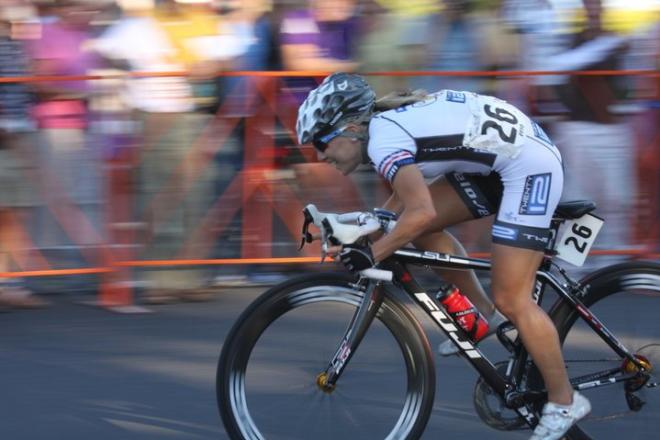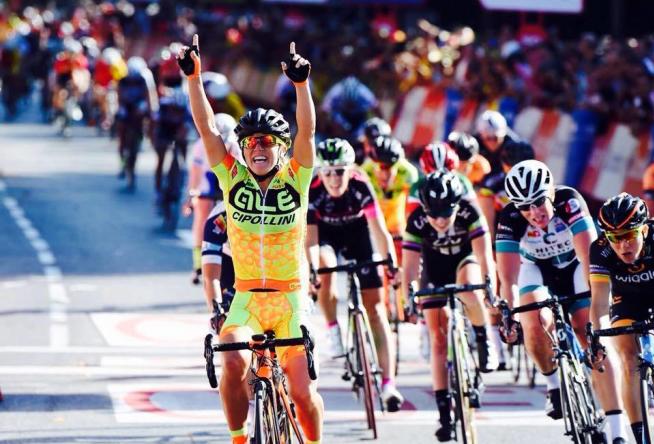“For the first time, I’m starting to ride my bike again,” says U.S.A. Olympic cyclist Shelley Olds.
“I associated so much of my pain with the bike. And so even though I had such beautiful memories and I loved racing, I traveled the world, I met incredible people, and went to the Olympics, I hated the bike because I just associated [it] with pain.”
As the coach of Roanoke College’s new competitive cycling team, Olds has a career’s worth of athletic knowledge, as well as crashes for her team to learn from.
“One of my very first training rides before I even started to race, I got hit by a motorcycle,” said Olds, pointing to the large scar on her hand from the event. “I hit the motorcycle with my hand, went over the handlebar, and rolled down a mountain. I had to be taken out in a helicopter.”
That accident caused Olds’ first major concussion, but it would not be her last. At the time, she was more worried about her broken hand and other external injuries, yet it didn’t discourage Olds from riding in the slightest. She raced professionally for ten years and experienced ten significant head injuries along the way.
“I remember one time in the Velodrome on the track, I got launched off my bike and went straight into a pole. I went right into that with my head and then fell to the floor,” Olds recalled.
Her next collision at the World Championships left little time for a break, (or any brakes, literally).
“There was a crash up the track and because you're on a bike with no brakes, you can't react. The person up the track slid down the track because it's banked and she took out the entire field,” explains Olds. “We couldn't brake, we couldn't go anywhere. We all crashed. I lost all control of the front of my handlebar. The bike was split in half. I cracked my teeth and that's how I stopped my fall.”
This resulted in another concussion for Olds. Despite being shaken up, she raced the next day.

“With every crash, not only was I getting more injured, and I could feel that it was taking longer to be normal again after getting my bell rung; I also was getting more scared,” Olds remembers.
In February of 2016, she was racing in Belgium when she experienced her worst head injury yet.
“It was a rainy day and the group had split up. I was coming around this corner really fast and there was a rider down in the middle of the road on cobbles, and I hit her head-on because I didn't see her,” Olds says. After hitting the cyclist, she slammed headfirst into the rocks, cracking her helmet.
“I knew it was really bad,” recalls Olds. “At the time, I had a really aggressive coach, and he was like, ‘Get up, can you go? Can you go?’ and he picked me back up and pushed me, saying ‘You're fine, right? You're fine.’”
“Your adrenaline pumps and if you don't have a broken hand or rib or something, you just go and you deal with it later. The next night, I got on a flight to Italy for the next race. These are big races, and I'm trying to make the Olympic team, but I knew I wasn't right,” reflected Olds, who crashed again that April.
Taking time off, she stayed in Lake Tahoe for two months and saw a sports concussion specialist. Her doctors performed an MRI, finding significant bruising on her head. After crashing so many times, the discs in her neck were starting to protrude out. It was then that Olds was diagnosed with post-concussion syndrome and a traumatic brain injury.
One of the most detrimental side effects Olds experienced was sensory overload. The pain from overstimulation, even at a tranquil resort destination, was more than she could bear.
“The light from the computer or the TV or the phone would make me nauseous to the point that I would vomit. I couldn't walk outside. Every step I took was a vibration pounding in my head. I had to wear glasses and a hat and just stay out of the sun and not open my eyes or block everything. Inside the house I just kept everything closed. It was so depressing. You're just stuck in this hole,” said Olds.

That hole ultimately forced Olds to retire from the sport. Due to the injuries, Olds’ brain did not have the ability to block out ambient sights and sounds and allow her to focus on isolated tasks or conversations in her environment. Daily headaches plagued her for the next two years. She wanted to go back to school during her time off for physical therapy but was unable to read and study. While riding wasn’t possible during this time, Olds still felt the desire and outside pressure to return to the sport she loved so much, despite experiencing fear and panic from the smallest sensations. Slowly, she started working again at a gym while fighting a battle inside her head that no one else could see.
Dr. Justin Weppner is board-certified in brain injury medicine, a subspecialty, along with being a physiatrist at Carilion Clinic’s Brain Injury Center, which offers a comprehensive multidisciplinary approach with multiple providers to get someone better.
“The frustrating part for the patient is that loved ones or friends may not recognize all the deficits that are there, even colleagues and coworkers. It’s the invisible symptoms that really can be debilitating,” says Dr. Weppner, who confirms multiple concussions, especially without proper care and rest in between those events, can lengthen the recovery process.
“I often tell patients that one concussion plus one concussion does not equal two. One concussion plus one concussion can equal four to five concussions. The more head injuries you have, the worse it can be,” he explains. “Typically, with one concussion, about 80% are going to resolve in the first few weeks, 10% are in the first few months, and then there's 10% of concussions that really last beyond three months and can be quite troublesome.”
When the COVID-19 pandemic closed her gym, Olds took the time to finally be treated for her carpal tunnel and neck injuries and underwent more testing to determine how she could improve her brain health. In the summer of 2022, Olds took part in what she describes as a life-changing trial treatment of brain frequency therapy in Southern California.
Along with her new position at Roanoke College, Olds is also the active sports director for the professional Roanoke-based women’s cycling team, Virginia’s Blue Ridge TWENTY24. This past summer, Olds witnessed a team member crash during a race and was able to advise her athletes on how to respect the injury and take the time needed to recover. For many female athletes, sitting out from a race could mean losing their next paycheck or getting cut from the team. However, VBR TWENTY24 team members and coaches share a mutual respect for mental and physical health while striving toward their goals.
“It was a mistake every time I got back on my bike right away. I needed a few days there to let my brain settle down. I think if I had done things differently, I would've saved a couple of years of my life that I missed out on,” said Olds. “I don’t want my riders to be afraid of crashing. It’s part of the sport and it can happen. But I still think that you can have a lot of fun and you can treat it better. And I think my experience will help.”
The Carilion Brain Injury Center in Roanoke sees people from all over the region, with two brain injury medicine providers who specialize in physical medicine & rehabilitation as well as a neuropsychologist on staff who can perform cognitive testing, and a physical therapist who does vestibular rehabilitation.
Dr. Weppner says it’s important for people to know the signs of brain injuries, which can include headaches, dizziness, nausea, blurry vision, difficulty with thinking, and changes in sleep or mood. Seeking care early and getting on top of symptom management is imperative for recovery. Specifically, resting for the first 24 to 48 hours after the event, making sure to get plenty of sleep and cutting back on screen time.
“You don't have to be knocked out to be diagnosed with a concussion or a head injury. You don't even have to hit your head. You just need to have forces on your brain that can cause a concussive event,” explains Dr. Weppner. “Sometimes people have a whiplash event. Your brain is like Jell-O inside the skull and if it bounces around, that in itself can be enough force to cause a mild traumatic brain injury or concussion.”
And now in 2022, for the first time in four years, Shelley Olds is back on the bike. After finally finding the care that was right for her, she says she is feeling more like herself than she has in years.
“I’ve been getting the itch to ride again, and it feels good. This is my favorite time of year and I love to be outside. Carvins Cove is epic, and safe, and really well-marked and everything,” said Olds. “Cycling is too hard to resist in Virginia.”
Patients should follow up with their physicians, and if symptoms continue for a week, patients can get a referral to the Brain Injury Center, or call (540) 224-5170 for more information.












